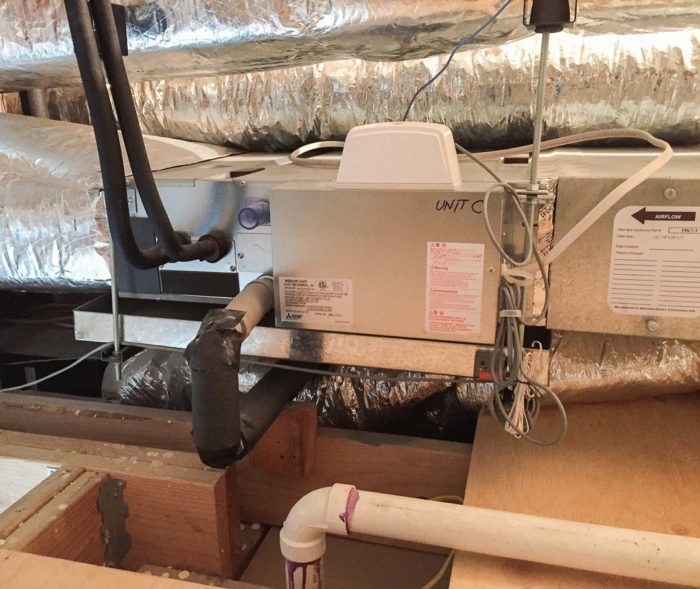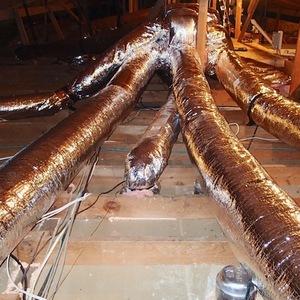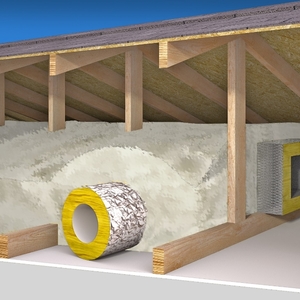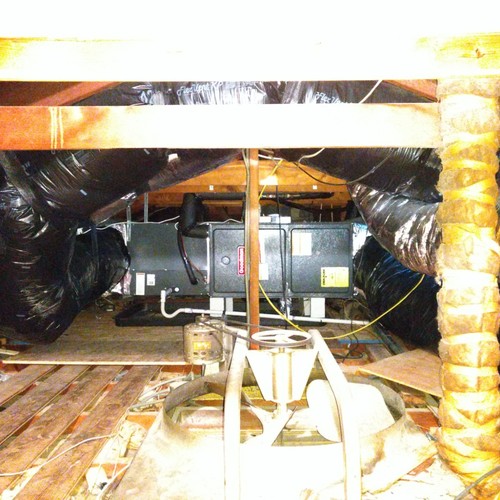
Image Credit: Mitsubishi Electric
A GBA reader named Inverter0815 lives in a two-story colonial in New Jersey that’s hard to keep comfortable in summer. In order to get the three upstairs bedrooms down to a relatively comfortable 75°F in July and August, Inverter must set the thermostat on his single-zone 2 1/2-ton air conditioner to 67°F.
An HVAC contractor has taken a look at the house and has a recommendation, Inverter explains in this Q&A post: install two Mitsubishi SEZ model ducted minisplits in the attic. One will cool the master bedroom, the other will cool the two bedrooms where Inverter’s children sleep.
There’s one snag. The attic at Inverter’s house is unconditioned.
“What got me thinking is that Mitsubishi recommends installing the SEZ units in a dropped ceiling or closet,” Inverter writes. “Can these be installed in an unconditioned attic as well? The [temperature] gets up to 130°F on a sunny day in the summer, so I am a little worried. Would a traditional air handler be a better idea?”
That’s the underlying question for this Q&A Spotlight.
The units seem oversized
What strikes Chris King first, though, is the capacity of the minisplits that the contractor has recommended. At 20,000 Btu/hour, King says, they seem “incredibly overpowered” for cooling just three bedrooms.
“I also live in N.J. and use a 18,000 Btu/h unit for 1,500 square feet of 1960s poorly insulated home,” King says. “Seems like your biggest issue is that your current system is single-zone.”
Each of the units the contractor recommends, however, can be dialed back to 3,800 Btu per hour, Inverter says, and the output of the outdoor condenser can be lowered to 6,000 Btu/h. That means that if both units are running, each can operate at between 3,800 and 12,000 Btu/h.
Another…
Weekly Newsletter
Get building science and energy efficiency advice, plus special offers, in your inbox.

This article is only available to GBA Prime Members
Sign up for a free trial and get instant access to this article as well as GBA’s complete library of premium articles and construction details.
Start Free TrialAlready a member? Log in















3 Comments
mini-split replacement question?
Are the minisplit manufacturers of ducted minis now recommending their systems for replacing legacy, in-place ducted A/C systems? Without regard to in-place ducting?
Similarly, are any manufacturers selling "regular" ducted heat pump systems with inverters? And COPs that compete with the minisplit systems?
Short answers, yes, and yes.
The Carrier Infinity Greenspeed, Bryant Evolution Extreme, and Trane XB20i models are all modulating inverter drive heat pump systems.
Mitsubishi's MVZ series ( https://meus.mylinkdrive.com/files/M-Series_MVZ_Multi-Position_Air_Handler.pdf ) and PVA series (http://www.mitsubishicomfort.com/taxonomy/term/43163 ) air handlers are suitable for retrofitting to pre-existing ducts, as are Daikin's ARUF series (http://www.daikinlatam.com/download/SS-DARUF.pdf ) and LG's ARNU vertical ducted series (http://www.lg-vrf.com/vertical-ahu.aspx/ARNU123NJA4 ).
I'm sure there are others.
We have dealt with this
We have dealt with this problem several times, equipment and duct work in un-conditioned attics. This situation exists all over CT. The duct work is always a disaster of bent, crimped and stepped on flex so we remove all the flex, air seal the floor/2nd floor ceiling, put in a plywood floor if there was none, vent & insulate the rafters with Roxul or fiberglass spanned with 1-2” foil or white vinyl faced polyiso board, tape the joints, re-install duct work using as much hard pipe as possible and correctly installed flex. Its labor intensive and costly (but probably not more than all the new equipment). It works, the heating, and cooling becomes more uniform and it cuts their utility bills. Plus, the home owners love how neat and clean their attic look when its all done. All the material you need for this is readily available at the local lumber yard and is simple to install. The white vinyl faced polyiso has to be special ordered by the pallet-also, it is fire rated so some owners want it for that reason.
Log in or become a member to post a comment.
Sign up Log in